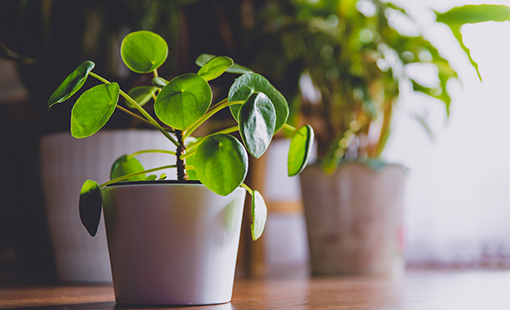
Pilea Profile
Pilea is a genus consisting of more than 600 species of frost-tender, tropical foliage plants—including both upright bushy types and trailing varieties. Several smaller species are commonly cultivated as houseplants because they are easy to grow and care for. They make great starter plants for inexperienced growers. They are best planted outdoors in the spring, and indoors you typically can start a plant at any point during the growing season. In general, these plants are moderate to fast growers. Pilea foliage varies considerably, ranging from 3-inch textured and lance-shaped leaves to tiny heart-shaped and moss-like foliage. Pileas occasionally bloom, but their pink or cream flowers are very tiny and often go unnoticed.
Care
Pileas are fairly low-maintenance and forgiving plants. With even minimal attention toward watering, they will generally thrive and continuously put out new foliage through the summer months. In the winter, the growth will slow. When growing in containers, plan to repot your pilea annually in the spring in a slightly larger pot. Or start a new plant from cuttings and discard the old plant if you don’t have the space for a large pot.
All pileas tend toward legginess and have fairly brittle stems. To encourage a compact, bushy plant, you can pinch off the tips of new growth on branching forms of pilea. But keep in mind that even dedicated attention can’t stop the plant from eventually looking a little bedraggled and unattractive because its lower leaves naturally drop with age. When this happens, you can start a new plant from cuttings if you wish.
Light
Most pilea species like bright, indirect light. Do not expose them to direct summer sun, as this can burn the leaves. Indoors, a bright windowsill is a suitable spot. Make sure to rotate the pot at least a couple times a week, as the plant will stretch toward the sun and begin to grow lopsided if you don’t. Pilea can tolerate low light, but its foliage will turn a darker green and it will become leggy.
Soil
Pilea plants prefer a moderately rich, well-draining potting mix. Soggy soil can cause root rot and kill a plant. A peat moss-based potting mix with leaf mold and perlite added, or a mix specifically for African violets, is often beneficial.
Water
Pilea plants have medium to high water needs. Water whenever the first inch of soil dries out. You might notice the leaves drooping, which can signal the plant’s need for more water. In hot weather, you’ll likely have to water more often.
Temperature & Humidity
Pilea plants generally prefer temperatures over 50 degrees Fahrenheit, and frost can be deadly to the plants. Indoors, they’re happy at a room temperature between 65 and 75 degrees Fahrenheit. Make sure your plant is situated away from vents that can blow extremely cold or hot air on it. Moreover, pilea plants enjoy a moderate to high humidity level and can be grown in terrariums.
Fertilizer
Fertilizer often isn’t necessary when pilea is planted outdoors in its growing zones. When growing pilea in containers, use a liquid houseplant fertilizer at half strength once in the spring and again in the summer.
Information courtesy of TheSpruce.com

 Adams Fairacre Farms
Adams Fairacre Farms